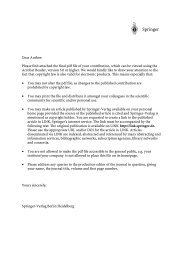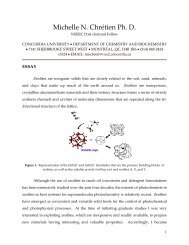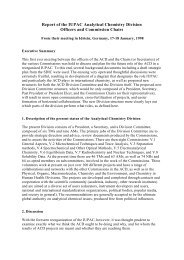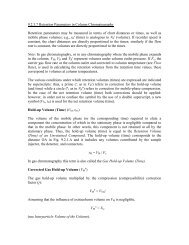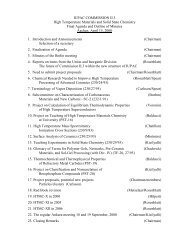9.2.4.5 Operation Ranges Linear Range The linear - iupac
9.2.4.5 Operation Ranges Linear Range The linear - iupac
9.2.4.5 Operation Ranges Linear Range The linear - iupac
Create successful ePaper yourself
Turn your PDF publications into a flip-book with our unique Google optimized e-Paper software.
<strong>9.2.4.5</strong> <strong>Operation</strong> <strong><strong>Range</strong>s</strong><br />
<strong>Linear</strong> <strong>Range</strong><br />
<strong>The</strong> <strong>linear</strong> range of a chromatographic detector represents the range of concentrations or<br />
mass flows of a substance in the mobile phase at the detector over which the sensitivity of<br />
the detector is constant within a specified variation, usually ±5 percent.<br />
<strong>The</strong> best way to present detector <strong>linear</strong> range is the <strong>Linear</strong>ity Plot (see Fig. 9.2.5) plotting<br />
detector sensitivity against amount injected, concentration or mass flow-rate. Here, the<br />
upper limit of <strong>linear</strong>ity can be graphically established as the amount (concentration, or<br />
mass flow-rate) at which the deviation exceeds the specified value (± x % window around<br />
the plot). <strong>The</strong> lower limit of <strong>linear</strong>ity is always the minimum detectable amount<br />
determined separately for the same compound.<br />
Figure 9.2.5 <strong>Linear</strong>ity plot of a chromatographic detector. <strong>The</strong> scale of the ordinate is<br />
<strong>linear</strong>: the scale of the abscissa may be either <strong>linear</strong> or logarithmic.<br />
Alternatively, the <strong>linear</strong> range of a detector may be presented as the plot of peak area<br />
(height) against concentration or mass flow-rate of the test substance in the column<br />
effluent at the detector (see Fig. 9.2.6). This plot may be either <strong>linear</strong> or log/log. <strong>The</strong><br />
upper limit of <strong>linear</strong>ity is that concentration (mass flow-rate) at which the deviation from<br />
an ideal <strong>linear</strong>ity plot is greater than the specified percentage deviation (± x % window).<br />
Numerically, the <strong>linear</strong> range can be expressed as the ratio of the upper limit of <strong>linear</strong>ity<br />
obtained from the <strong>linear</strong>ity plot and the minimum detectability, both measured for the<br />
same substance.
When presenting the <strong>linear</strong> range of a detector, either as a plot or as a numerical value,<br />
the test substance, the minimum detectability, and the specified deviation must be stated.<br />
Dynamic <strong>Range</strong><br />
<strong>The</strong> dynamic range of a detector is that range of concentration or mass flow-rates of a<br />
substance over which an incremental change in concentration or mass flow-rate produces<br />
an incremental change in detector signal. Fig. 9.2.6. presents a plot used for the<br />
determination of the dynamic range of a detector.<br />
<strong>The</strong> lower limit of the dynamic range is the minimum detectability. <strong>The</strong> upper limit is the<br />
highest concentration at which a further increase in concentration (mass flow-rate) will<br />
still give an observable increase in detector signal, and the dynamic range is the ratio of<br />
the upper and lower limits. <strong>The</strong> dynamic range is greater than the <strong>linear</strong> range.<br />
Numerically the dynamic range can be expressed as the ratio of the upper limit of the<br />
dynamic range obtained from the plot and the minimum detectability, both measured for<br />
the same substance.<br />
When expressing the dynamic range of a detector, the test substance and the minimum<br />
detectability must be stated.<br />
Figure 9.2.6 Determination of the <strong>linear</strong> and dynamic ranges of a chromatographic<br />
detector. Such a plot is usually in a log-log scale.





